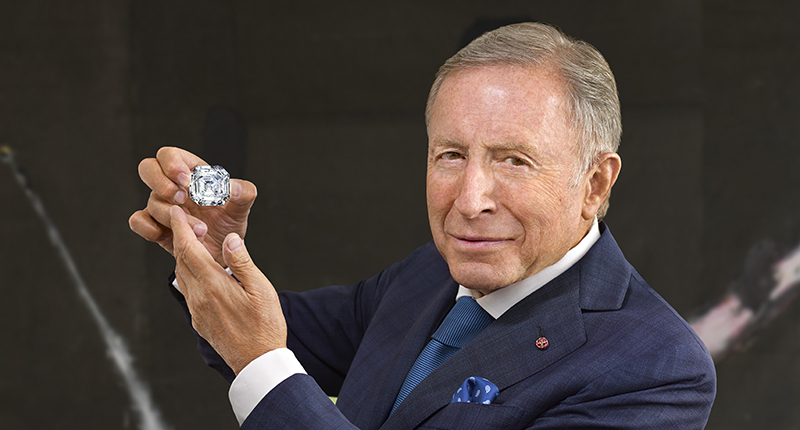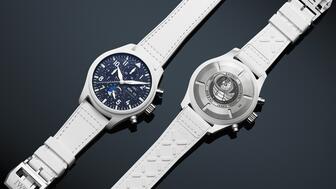Said to be the first to write a jewelry sales manual for the industry, Zell is remembered for his zest for life.
Graff Cut This 302-Carat Diamond from Lesedi La Rona
Lesedi La Rona was the 1,109-carat rough diamond discovered in Botswana almost four years ago.

New York—Graff has unveiled the principal polished diamond cut from Lesedi La Rona, the 1,109-carat chunk of rough discovered in Botswana in 2015.
It is a square emerald-cut stone that weighs 302.37 carats and is the largest diamond ever graded by the Gemological Institute of America as being of highest color, D, and “highest clarity.” A Graff spokeswoman could not confirm the diamond’s exact clarity grade by press time Wednesday.
The stone, which has been named the Graff Lesedi La Rona, also holds the distinction of being the largest square emerald-cut diamond in the world, the company said.
Laurence Graff (no relation to author), who’s become known as the modern-day Harry Winston for handling many of the largest and most spectacular diamonds of the last century, called crafting the Graff Lesedi La Rona “an honor.”
“This diamond, our diamond, is beyond words,” he said. 
Workers for Lucara Diamond Corp. found the 1,109-carat rough diamond (originally 1,111 carats before cleaning) at the Karowe mine in November 2015.
A naming contest open to all Botswana citizens was held a few months later and Thembani Moitlhobogi submitted the winning moniker, which means “Our Light” in Tswana, the official language of Botswana.
Lucara put the stone up for auction at Sotheby’s in June 2016 but bidding failed to reach the reserve price of $70 million, so the stone went unsold until Graff stepped forward in September 2017. The company paid $53 million, or about $48,000 per carat, for Lesedi La Rona.
Chipping Away
Before he even purchased the diamond, Graff had some idea how cutting the Lesedi La Rona would go.
In May 2017, the London-based diamantaire bought a 373.72-carat chunk of rough thought to have chipped off Lesedi La Rona, so he knew the stone could result in “sensational” polished diamonds.
Even so, Lesedi La Rona’s size presented a challenge to Graff’s gemologists because they had never analyzed a stone of that size. Lesedi La Rona is the second largest gem-quality rough diamond on record, topped only by the 3,106-carat Cullinan, which was discovered in 1905.
The tennis ball-sized diamond was too big for the company’s existing equipment, so a scanner had to be custom built with brand new imaging software.
Using the
WATCH: The Cutting of Lesedi La Rona
{youtube}3LSHnLj-utw{/youtube}
The analysis continued for months before gemologists moved forward with a plan for cutting and polishing the diamond. Laurence Graff described the task of cutting a diamond of this size as “the riskiest form of art.”
“You can never add and you can never cover up a mistake, you can only take away,” he said. “You have to be careful, and you have to be perfect.”
The initial cutting was done with lasers, while the following shaping and faceting was done by hand. The company said polishing the table facet alone took “hundreds of hours.”
All told, a little more than 18 months elapsed between the time Graff bought the diamond in September 2017 and when his gemologists and craftsmen finished polishing its final facets.

Neither the asking price for the Graff Lesedi La Rona nor its current location are being disclosed.
Fragments from the cutting of the stone were donated to the Smithsonian Institute to help its advanced diamond research, as the Lesedi La Rona has been identified by GIA as being a “superdeep” diamond, a stone that, like blue diamonds, formed three times deeper in the earth than other diamonds.
The Graff Lesedi La Rona is one of 67 diamonds cut from the 1,109-carat rough, the first of which were unveiled late last year.
The Latest

The company outfitted the Polaris Dawn spaceflight crew with watches that will later be auctioned off to benefit St. Jude’s.

A buyer paid more than $100,000 for the gemstone known as “Little Willie,” setting a new auction record for a Scottish freshwater pearl.

Supplier Spotlight Sponsored by GIA.

Anita Gumuchian created the 18-karat yellow gold necklace using 189 carats of colored gemstones she spent the last 40 years collecting.


The three-stone ring was designed by Shahla Karimi Jewelry and represents Cuoco, her fiancé Tom Pelphrey, and their child.

The Manhattan jewelry store has partnered with Xarissa B. of Jewel Boxing on a necklace capsule collection.

Supplier Spotlight Sponsored by GIA

Acting as temporary virtual Post-it notes, Notes are designed to help strengthen mutual connections, not reach new audiences.

The jewelry historian discusses the history and cultural significance of jewelry throughout time and across the globe.

From fringe and tassels to pieces that give the illusion they are in motion, jewelry with movement is trending.

The designer and maker found community around her Philadelphia studio and creative inspiration on the sidewalks below it.

The change to accepted payment methods for Google Ads might seem like an irritation but actually is an opportunity, Emmanuel Raheb writes.

The industry consultant’s new book focuses on what she learned as an athlete recovering from a broken back.

The fair will take place on the West Coast for the first time, hosted by Altana Fine Jewelry in Oakland, California.

Hillelson is a second-generation diamantaire and CEO of Owl Financial Group.

Submissions in the categories of Jewelry Design, Media Excellence, and Retail Excellence will be accepted through this Friday, Aug. 23.


Known as “Little Willie,” it’s the largest freshwater pearl found in recent history in Scotland and is notable for its shape and color.

Clements Jewelers in Madisonville cited competition from larger retailers and online sellers as the driving factor.

Most of the 18th century royal jewelry taken from the Green Vault Museum in Dresden, Germany, in 2019 went back on display this week.

The Pittsburgh jeweler has opened a store in the nearby Nemacolin resort.

With a 40-carat cabochon emerald, this necklace is as powerful and elegant as a cat.

The Erlanger, Kentucky-based company was recognized for its reliability when it comes to repairs and fast turnaround times.

Unable to pay its debts, the ruby and sapphire miner is looking to restructure and become a “competitive and attractive” company.

The trend forecaster’s latest guide has intel on upcoming trends in the jewelry market.

Ingraham said she’ll use the scholarship funds to attend the Women’s Leadership Program at the Yale School of Management.

Moijey Fine Jewelry & Diamonds held a three-week “Mine to Finger 3D Jewelry Program.”



























